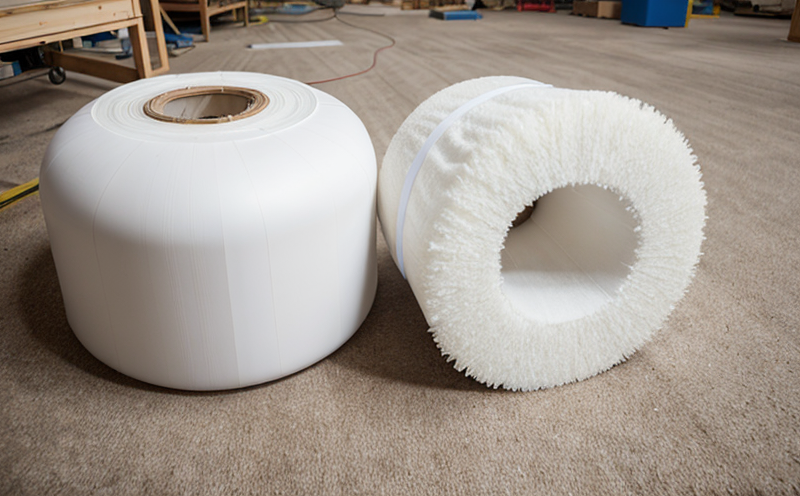ASTM E90 Laboratory Sound Transmission Loss Testing
The ASTM E90 Standard Test Method is a critical component in assessing sound insulation properties of building materials and assemblies. This method evaluates the ability of a material or assembly to reduce the amount of airborne sound that passes through it, quantified as sound transmission loss (STL). STL testing is essential for ensuring compliance with various international standards such as ISO 140-4 and ASHRAE 53.
The ASTM E90 procedure involves placing a test specimen between two chambers within a controlled environment. One chamber, the receiving room, is exposed to sound from an external source while the other, the source chamber, contains the noise generator. The specimens are typically made of materials used in construction, such as walls, partitions, and doors.
The testing setup consists of a three-room configuration: two test chambers separated by the specimen under test and a third room that serves as an ambient reference point. The sound field is generated using a random incidence noise source, which ensures uniformity across the entire surface area of the specimen being tested. This setup allows for precise measurement of STL over specific frequency ranges.
The primary goal of ASTM E90 testing is to determine how effectively materials and assemblies block sound transmission from one room to another. The results provide critical insights into the acoustic performance of building elements, helping architects, engineers, and construction professionals design spaces that meet stringent noise control requirements. By employing this standard test method, organizations can ensure their products are compliant with relevant regulations while also enhancing user comfort by minimizing unwanted noise penetration.
Key aspects of ASTM E90 include:
- The use of a three-room setup for accurate STL measurement
- A random incidence noise source to simulate real-world conditions
- Detailed frequency analysis for comprehensive data interpretation
- Compliance with international standards such as ISO 140-4 and ASHRAE 53
This testing is particularly important in sectors like residential construction, commercial buildings, healthcare facilities, and educational institutions where soundproofing is crucial. By leveraging ASTM E90, businesses can significantly improve the acoustical performance of their products, thereby enhancing customer satisfaction and operational efficiency.
At Eurolab, we pride ourselves on providing meticulous testing services that adhere strictly to industry best practices. Our experienced team ensures that every specimen undergoes rigorous examination using state-of-the-art equipment and methodology. The accuracy and reliability of our results make us the go-to choice for clients across various sectors who require precise STL assessments.
Industry Applications
The ASTM E90 test method finds extensive application in several industries, including:
- Residential construction: Ensuring that walls and partitions effectively block noise between rooms
- Commercial buildings: Designing spaces that minimize sound interference in open-plan offices or meeting rooms
- Hospitality sector: Creating quieter environments for hotels, resorts, and other accommodation facilities
- Education: Improving the learning experience by reducing background noise in classrooms and libraries
- Healthcare: Enhancing patient comfort and privacy in hospital wards and clinics
- Retail spaces: Providing a more pleasant shopping experience by minimizing unwanted sound disturbances
- Sports facilities: Ensuring that spectators are not disturbed by the sounds from adjacent areas
In each of these applications, ASTM E90 plays a pivotal role in ensuring that the acoustic performance of materials and assemblies meets or exceeds regulatory standards. By incorporating this testing into their quality assurance processes, organizations can significantly enhance the comfort and well-being of users.
Eurolab Advantages
At Eurolab, we offer unparalleled expertise in ASTM E90 sound transmission loss testing, delivering accurate results that are not only compliant with international standards but also exceed expectations. Our key advantages include:
- State-of-the-Art Facilities: Equipped with advanced equipment and technology to ensure precise measurements.
- Experienced Technicians: Our team comprises highly skilled professionals who are well-versed in the latest testing techniques.
- Comprehensive Reporting: We provide detailed reports that offer actionable insights into STL performance, helping clients make informed decisions.
- Rapid Turnaround Times: Efficient processes allow us to deliver results quickly without compromising on quality.
- Client-Centric Approach: Tailored solutions and personalized support for every client’s unique needs.
- International Recognition: Our services are recognized globally, ensuring that clients receive world-class testing.
We understand the importance of accurate STL testing in various sectors, and we strive to provide reliable results that contribute positively to our clients' success. Whether you're a manufacturer, designer, or specifier, Eurolab's commitment to excellence ensures that your products meet stringent acoustic performance criteria.





